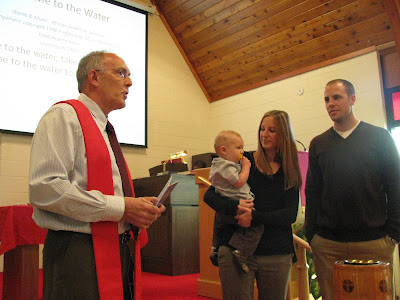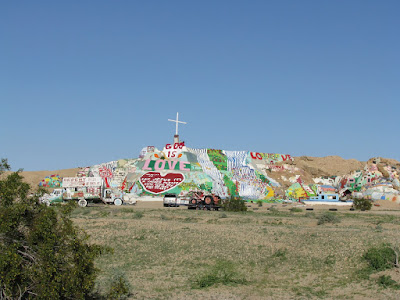Hi everyone! We are catching up slowly but surely. Drill is same as before - oldest posts at the bottom, most recent at the top so scroll to the bottom and work your way up. Captions are at the bottom of the picture.

October 1 2010 – September was a busy month. We worked around the house. Ted went golfing with his Vulcan buddies at Whitefish. We visited Clayton, Mel and Hunter, Joyce and family and Chris again, had farewell lunches and suppers with friends and then it was time to head south. Hunter saw us off with a special wave good-bye.

Here we are at the Buffalo Jump. Natives herded the buffalo over the cliff and then killed those that hadn’t died from the fall. They used every part of the buffalo for food, clothing, shelter, tools, etc. Nothing was wasted. There were several forest fires burning in the area the day we were there. The thick smoke made it difficult to see anything in the distance. The rest of the day was spent in Nanton visiting all the antique stores. It was a busy few days but a lot of fun.

August 20 – We started our day at Head Smashed In Buffalo Jump near Fort Macleod

Our last stop of this very busy day was supper at Clayton and Melanie’s. Hunter was supposed to be helping pull lettuce from the garden but he found the dirt to be a lot more fun.

Then it was off to the Rosedale Suspension Bridge

Dayna had never even heard of a hoodoo, let alone seen one, so we had to rectify that lapse in her geological education.

Dayna was getting a little overstimulated by this time and insisted on riding one of the little dinosaurs found around the town of Drumheller

Outside we made friends with one of the local dinosaurs.

This is an interesting species found in the Burgess Shale exhibit. If you have never been to this Museum, you should go. It’s incredible.

August 19 – Dayna is really interested in geology and taking a few courses at university so we thought she might enjoy the Tyrell Museum

Beautiful Lundbreck Falls. Then it was off to Mountain View

After lunch in Blairmore, our next stop was Leitch Collieries just west of Lundbreck. It was built in 1907 and folded in 1915 due to labour strikes, difficulties getting the coal from the mine, a soft coal market and bankruptcy. Many of the structures were constructed from stone and are still standing today including the owner’s house. At one point there were 101 coke ovens, a 27 metre (90 foot) wooden washery, a huge tipple with a daily capacity of between 1,000 and 2,000 tons of coal and a large sandstone power house. Teresa is standing in the foreground of the power house and Dayna is lying on a sill in the background.

This is what Turtle Mountain

August 18 – Joyce, daughter Teresa and granddaughter Dayna came for a visit. Our first outing was to the Frank Slide Interpretive Centre where we learned all about what happened when tons of rock from the summit of Turtle Mountain slid down the mountain in the early morning hours of April 29, 1903 covering most of the town of Frank

August 7 – We went to nearby Crimson Lake

Uncle Chris went cruising around the pool with Hunter.

August 6 – We spent our annual Salken family weekend at Wilderness Village

Here are the happy couple renewing their vows at the “Church of the Open Bottle”.

July 31 – Our friends Wayne and Audrey celebrated their 40th wedding anniversary at their daughter’s farm. Even though they didn't live too far from us when we lived in Wetaskiwin, we didn't meet them until we were both at a campground in Baddeck , NS

July 17 – We spent a few days visiting Joyce and family. Southern Alberta and Saskatchewan

Lisa, Caitlyn and Daniel

Hunter getting to know great-uncle Dave.

July 11 – We spent the day at the home of Ted’s brother and sister-in-law, Dave and Ornell. Their daughters, Jody and Lisa and grandchildren, Caitlyn and Daniel, (also from the Island) were spending a few days with them. From front to back: Jody, Caitlyn and Lisa.

June 14 – While we were visiting Chris, Ted’s nephew, Jon, and his girlfriend, Jo, from the Island dropped by for a visit while on holiday.

Our family. Ken’s death has left a big hole in our family. He was dearly loved and will be greatly missed by all of us.

June 1 – Unfortunately all the joy of Hunter’s birthday and his baptism was overshadowed by the death of my wonderful brother-in-law, Ken, on May 27. As soon as we finished lunch after the baptism, we all headed to Joyce's. Somehow it seems the only time we get family pictures is at weddings and funerals. Mel, Chris, Clayton and Hunter were joined by Dayna , Jordan

May 30 – A second big day in Hunter’s life – his baptism.

Of course, Uncle Chris had to help Hunter eat his cake.

May 29 – We celebrated Hunter’s first birthday a few days early. Grandpa and Grandma, Uncle Chris, the next door neighbours and Ted and I (Papa and Nana) joined the birthday boy and his mom and dad for cake and presents. Mel baked and decorated the giraffe cake – pretty neat, hey? Hunter certainly seems to be enjoying it.

Hunter and I sat in the grass, picked weeds and enjoyed the sunshine.

Hunter pointing something out to his proud Papa.

May 15 - The first month after we returned home was spent visiting Chris, Clayton, Mel, Hunter, Joyce, Ken and family. Mel and Hunter came down for a few days in May so we decided to spend a day at the farm. Hunter loved playing peek-a-boo behind the lawn furniture. Gotta love that cute face!!

April 18 – It was great to be home and see the kids and Hunter again. We couldn’t believe how much Hunter had grown since Christmas. He is just starting to walk on his own. He provides Mel with a good workout!












































